Attempt to bring an ancient Khmer sculpture home from NYC

The Metropolitan Museum of Art in New York City is displaying a sculpture that is believed to be an ancient Khmer king. Now an archaeologist in Buriram is fighting to bring it home to Thailand where he claims it belongs. The bronze sculpture was smuggled out of the country by antique traders, but a 67 year old local woman in the Ban Yang village recognizes it as an artefact her brother-in-law found 50 years ago digging in local ruins, and she hopes to prove that it originated in Thailand and should be returned.
The leader of the Samnuek 300 Ong conservation group, says the statue, which is about 110 centimetres high and has been nicknamed “Golden Boy” is believed to be a statue of King Jayavarman VI of the Khmer Empire from about 1080 to 1107 AD. The style indicates that the sculpture is not a Cambodian Khmer artefact, but rather Thai Phimai art. Also notable, the king is depicted as human as opposed to a god, which suggests that he was Buddhist.
The local woman in Buriram recounted taking the statue home and gently washing it, adding that despite a push to excavate more and find other valuables, the statue was the only thing unearthed at the site. Despite being the location of ancient temple ruins, the Fine Arts Department still has never declared the area an archaeological site, lessening the protection of any artefacts found in the area.
At the time, hopeful archaeologists hired locals for 100 baht a day to dig up the entire area around the Prasat Ban Yang ruins. Nothing more was found, and they dug so much that the area eventually flooded and became a pond before then being filled back in and converted into a public area for general multiple uses.
Now the fight is on to convince the US museum to send the bronze Khmer sculpture back to its rightful place in Thai history. Last year 2 stone lintels were returned from the Asian Art Museum in San Francisco and are being installed in Buriram and Sa Kaeo, where they originally stood in the 11th century.
The archaeologist is now gathering evidence – firsthand accounts like the Buriram woman who had once held the statue, and citing books published that recount the bronze sculpture’s discovery. Once they have sufficient data, they can approach the US and request that the ancient artefact be returned.
SOURCE: Thai PBS World
Latest Thailand News
Follow The Thaiger on Google News:


























